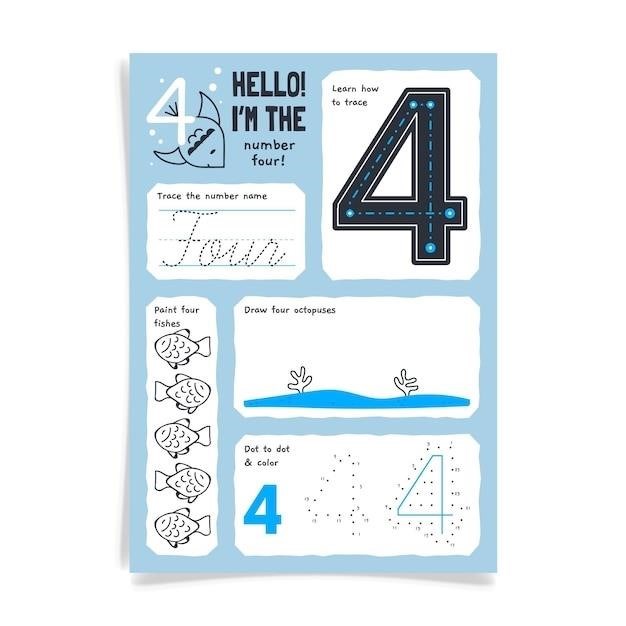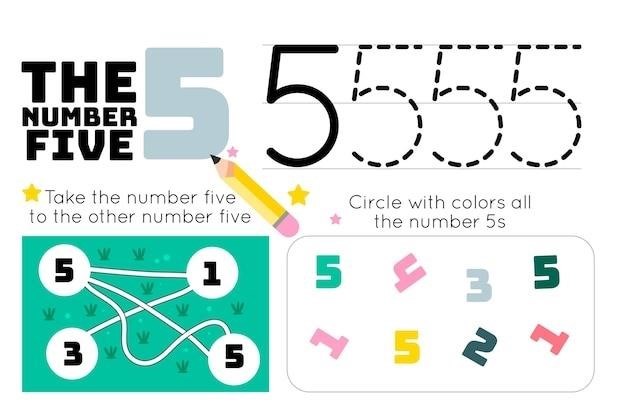Pathways to Math Literacy⁚ A Comprehensive Guide
This comprehensive guide explores the multifaceted world of math literacy, offering insights into its significance, benefits, and pathways to achieving it. We delve into various resources, strategies, and approaches tailored for diverse learners, from early childhood to adulthood. Discover how to cultivate math skills through real-world applications, engage students in learning, and provide essential support. Explore the future of math literacy, encompassing emerging technologies, data literacy, and inclusive learning opportunities. This guide serves as a valuable tool for educators, parents, and learners seeking to unlock the power of math literacy.
Understanding Math Literacy
Math literacy, often referred to as quantitative literacy or numeracy, transcends the mere ability to perform calculations. It encompasses a deeper understanding of mathematical concepts and their applications in real-world contexts. It involves the ability to interpret, analyze, and reason with mathematical information, effectively communicate mathematical ideas, and solve problems using mathematical tools. Math literacy is not merely about memorizing formulas or procedures; it’s about developing a critical and flexible mindset that empowers individuals to navigate a world increasingly driven by data and quantitative reasoning.
The Importance of Math Literacy in Everyday Life
In today’s data-driven world, math literacy is no longer a niche skill confined to academic settings; it’s an essential life skill. From managing personal finances and understanding health statistics to making informed consumer decisions and interpreting news reports, math literacy empowers individuals to navigate everyday challenges with confidence. It helps us make sense of the world around us, analyze information critically, and make sound judgments. A strong foundation in math literacy equips individuals to participate actively in society, fostering informed decision-making and promoting personal and professional growth.
Benefits of Math Literacy
The benefits of math literacy extend far beyond the classroom, impacting various aspects of an individual’s life. A strong grasp of math concepts enhances problem-solving abilities, fostering critical thinking and logical reasoning skills. This translates into improved decision-making in personal and professional spheres, empowering individuals to tackle complex issues and find effective solutions. Math literacy also opens doors to a wider range of career opportunities, as many fields demand a solid foundation in quantitative reasoning. Moreover, it fosters a deeper understanding of the world, enabling individuals to interpret data, analyze trends, and make informed choices in a world increasingly driven by information and technology.

Pathways to Math Literacy Resources
This section provides a curated list of resources to support your journey towards math literacy, ranging from textbooks and online platforms to free PDF downloads.
Textbooks and Manuals
Traditional textbooks and manuals remain valuable resources for building a strong foundation in math literacy. These resources often provide structured learning paths, detailed explanations of concepts, and practice exercises to reinforce understanding. “Pathways to Mathematical Understanding⁚ Early Childhood to Middle School” by Daniel Zaccaro and Edward Zaccaro offers a comprehensive guide for educators and parents seeking to nurture mathematical thinking in young learners. This book emphasizes the importance of hands-on activities and real-world applications to make math engaging and accessible for children. Another notable textbook, “Pathways to Math Literacy” by Dave Sobecki and Brian Mercer, is designed for developmental math courses and focuses on making math relevant to students’ lives. These textbooks and manuals offer a solid framework for acquiring essential math skills and knowledge.
Online Platforms and Websites
The digital age has revolutionized access to educational resources, and math literacy is no exception. Numerous online platforms and websites offer a wealth of materials, including interactive lessons, practice problems, and engaging videos. Websites like Khan Academy and Coursera provide free, self-paced courses covering various math topics, catering to different learning styles and levels. These platforms often feature adaptive learning algorithms that personalize the learning experience, providing targeted support based on individual needs. Online math communities and forums allow learners to connect with peers and experts, ask questions, and share insights, fostering a collaborative learning environment. The internet has democratized access to quality math education, making it more accessible and engaging for learners of all backgrounds.
Free PDF Downloads
The availability of free PDF downloads has significantly broadened access to educational materials, including those related to math literacy. Numerous websites and platforms dedicated to open access education offer a vast collection of textbooks, manuals, and other resources in PDF format. These resources are often made available by authors, publishers, and educational institutions committed to promoting knowledge sharing. Free PDF downloads empower individuals to learn at their own pace and convenience, eliminating financial barriers to accessing valuable educational content. Moreover, these downloads provide a convenient way to access and store learning materials for offline use, enabling learning on the go. The accessibility of free PDF downloads plays a crucial role in democratizing knowledge and fostering a more inclusive learning environment.
Creating a Pathway to Math Literacy
This section explores practical strategies for fostering math literacy in individuals of all ages and backgrounds.
Developing Math Skills Through Real-World Applications
Integrating math into everyday life is crucial for developing a genuine understanding and appreciation for its relevance. By connecting math concepts to real-world scenarios, learners can grasp their practical applications. For instance, cooking recipes provide opportunities to explore fractions, ratios, and measurement. Budgeting and financial planning involve understanding percentages, interest rates, and financial literacy. Engaging in activities like home improvement projects, gardening, or even playing board games can reinforce geometric concepts, spatial reasoning, and strategic thinking. These practical experiences not only enhance mathematical skills but also foster a sense of purpose and motivation, making learning more engaging and meaningful.
Engaging Students in Math Learning
To foster a positive and engaging learning environment, educators must move beyond traditional methods and embrace innovative approaches. Interactive games, puzzles, and hands-on activities can transform abstract concepts into tangible experiences. Incorporating technology, such as educational apps and simulations, can make learning more interactive and stimulating. Encouraging collaboration through group projects and peer-to-peer learning can promote critical thinking and problem-solving skills. Real-world applications, like conducting surveys or analyzing data from everyday life, can connect math to students’ interests and make learning more relevant. By creating a dynamic and engaging learning environment, educators can inspire a love for math and unlock students’ full potential.
Providing Support and Resources for Students
A supportive learning environment is crucial for students’ success in math literacy. Providing access to a variety of resources, such as textbooks, online platforms, and free PDF downloads, empowers students to learn at their own pace and in their preferred learning style. Offering tutoring services, peer mentoring programs, and study groups can provide additional support and guidance. Encouraging students to seek help when needed and fostering a culture of collaboration and respect can create a positive and encouraging learning environment. By providing comprehensive support and resources, educators can equip students with the tools they need to excel in math literacy.
Pathways to Math Literacy for Different Learners
This section explores tailored pathways to math literacy for diverse learners, considering their unique needs and developmental stages.
Pathways for Early Childhood
Laying the foundation for math literacy starts early. Engaging young children in playful activities that foster number sense, counting, and spatial reasoning is crucial. Pathways for early childhood focus on hands-on experiences, incorporating manipulatives, games, and real-world scenarios. These experiences make math tangible and relatable, sparking curiosity and fostering a positive attitude towards learning.
Resources like “Pathway to Mathematical Understanding in Early Childhood” provide valuable guidance for parents and educators. This book offers easy-to-understand explanations of key number concepts, along with activities and resources to develop them. It highlights the importance of nurturing mathematical thinking from the very beginning, setting the stage for future success.
Pathways for Middle School
Middle school marks a pivotal stage in math literacy development, transitioning from foundational concepts to more complex applications. Pathways for this age group emphasize connecting math to real-world scenarios, fostering critical thinking, and problem-solving skills. They encourage students to see math as a tool for understanding their surroundings, not just a set of abstract rules.
Textbooks and online resources tailored for middle schoolers provide engaging content and interactive exercises that make learning fun and relevant. Teachers can utilize these resources to create project-based learning experiences that challenge students to apply their knowledge to real-world problems. This approach helps students see the practical value of math, making them more motivated and confident in their abilities.
Pathways for Adult Learners
Adult learners often face unique challenges when pursuing math literacy. They may have gaps in their foundational knowledge or feel intimidated by the prospect of returning to formal education. Pathways for adult learners prioritize accessibility, flexibility, and relevance to their everyday lives. They recognize the diverse motivations and learning styles of adults, offering tailored approaches that cater to their individual needs.
Online platforms and free PDF downloads provide a convenient and flexible learning environment for adults. These resources often offer self-paced learning modules, allowing individuals to progress at their own speed. Moreover, adult learners benefit from resources that connect math concepts to practical applications in their careers, personal finances, or everyday decision-making. This approach empowers them to see the immediate value of math literacy and builds confidence in their abilities.
The Future of Math Literacy
The future of math literacy is intertwined with technological advancements, data-driven decision-making, and a commitment to inclusivity.
Emerging Technologies and Math Education
The integration of technology into math education is transforming the learning landscape, offering innovative pathways to math literacy. Interactive simulations, virtual reality applications, and adaptive learning platforms are revolutionizing how students engage with mathematical concepts. These technologies cater to diverse learning styles, provide personalized feedback, and foster a deeper understanding of abstract ideas; Artificial intelligence-powered tools analyze student performance, identify areas of weakness, and tailor instruction to individual needs. This personalized approach enhances student motivation and accelerates learning, making math more accessible and engaging for all.
Promoting Data Literacy in the Math Classroom
In today’s data-driven world, cultivating data literacy within the math classroom is paramount. This involves equipping students with the skills to interpret, analyze, and communicate information derived from data sets. Through hands-on activities, real-world case studies, and the use of data visualization tools, students can develop critical thinking skills, make informed decisions, and understand the impact of data on society. Integrating data literacy into the math curriculum empowers students to navigate the complexities of information, fostering a deeper understanding of mathematical concepts and their relevance in real-world scenarios. This approach equips learners to become responsible and informed citizens in an increasingly data-driven world.
Creating Inclusive Pathways for All Learners
The pursuit of math literacy should be accessible to all learners, regardless of their background, learning styles, or abilities. Creating inclusive pathways requires a multifaceted approach. This involves providing differentiated instruction, utilizing diverse learning materials, and fostering a supportive and inclusive classroom environment. By recognizing and addressing the unique needs of individual learners, educators can cater to diverse learning styles, provide appropriate accommodations, and create opportunities for all students to thrive. Inclusive pathways are essential for ensuring that every student has the chance to develop their mathematical skills and achieve their full potential. This commitment to equity and accessibility paves the way for a more inclusive and equitable educational landscape, where every learner can flourish.
